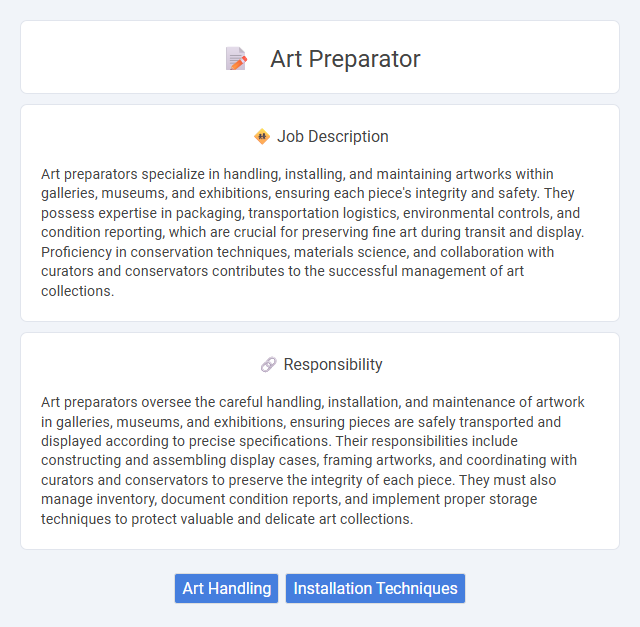
Art preparators specialize in handling, installing, and maintaining artworks within galleries, museums, and exhibitions, ensuring each piece's integrity and safety. They possess expertise in packaging, transportation logistics, environmental controls, and condition reporting, which are crucial for preserving fine art during transit and display. Proficiency in conservation techniques, materials science, and collaboration with curators and conservators contributes to the successful management of art collections.
Art preparator roles probably suit individuals with strong attention to detail, physical stamina, and problem-solving skills, as the job often involves handling delicate artworks and setting up exhibitions. People comfortable with manual tasks and working in controlled environments may likely find this work fulfilling, while those who prefer less physical activity or have difficulty managing fragile items might struggle. The position probably demands patience and precision, suggesting that candidates with these traits are more likely to succeed.
Qualification
An art preparator typically requires a background in fine arts, art history, or museum studies, coupled with hands-on experience in handling, installing, and maintaining artworks. Expertise in materials science, preservation techniques, and safety protocols is essential to ensure the integrity of diverse art pieces during transportation and exhibition. Proficiency in using specialized tools and knowledge of environmental controls enhances the ability to support curatorial staff and protect valuable collections.
Responsibility
Art preparators oversee the careful handling, installation, and maintenance of artwork in galleries, museums, and exhibitions, ensuring pieces are safely transported and displayed according to precise specifications. Their responsibilities include constructing and assembling display cases, framing artworks, and coordinating with curators and conservators to preserve the integrity of each piece. They must also manage inventory, document condition reports, and implement proper storage techniques to protect valuable and delicate art collections.
Benefit
Art preparator jobs likely offer significant benefits such as hands-on experience with valuable artworks, contributing to skill development in handling, installation, and preservation. There is a strong probability that working closely with curators and artists enhances professional networking opportunities within the art world. The role might also provide access to exclusive exhibitions and foster a deeper appreciation of diverse art forms.
Challenge
The role of an art preparator likely involves navigating complex challenges related to the careful handling and installation of diverse artworks, which requires both technical skill and precision. Managing the logistical aspects of transporting and conserving fragile pieces could present significant difficulties, demanding problem-solving abilities and adaptability. Success in this position may hinge on balancing artistic sensitivity with practical constraints, suggesting a dynamic and occasionally unpredictable work environment.
Career Advancement
Art preparators play a crucial role in the installation, maintenance, and conservation of artworks in galleries and museums, providing hands-on experience with valuable collections. Mastery in handling delicate materials, installation techniques, and conservation practices can lead to career advancement into curatorial roles, museum management, or specialized conservation fields. Expertise in project coordination and knowledge of art history enhances opportunities for leadership positions and higher responsibilities within cultural institutions.
Key Terms
Art Handling
Art preparators specialize in art handling, ensuring the safe packing, transportation, and installation of artworks with precision and care. They employ advanced techniques and materials to prevent damage during gallery setups, exhibitions, or relocations. Expertise in climate control, condition reporting, and mounting methods is essential to preserve the integrity of delicate or valuable pieces.
Installation Techniques
Art preparators specialize in advanced installation techniques to ensure the safe and precise placement of artworks in galleries and museums. They utilize tools such as brackets, mounts, and climate control systems tailored to each piece's material and fragility, emphasizing conservation standards. Mastery in spatial arrangement and structural integrity ensures artworks are displayed securely while preserving their aesthetic and physical condition.
 kuljobs.com
kuljobs.com